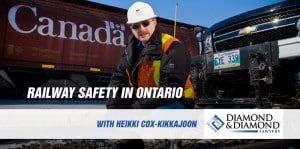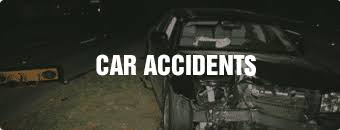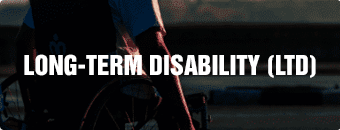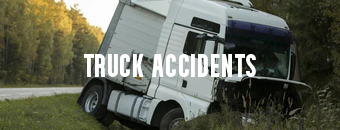- Our Firm
- Personal Injury
-
-
-
Personal Injury Lawyers
-
-
-
-
-
-
Injured in an accident? At Diamond & Diamond, our team of lawyers rely on their reputation in the field and extensive experience in personal injury to provide clients with a dedicated support system over the duration of their case.
-
-
-
-
-
HAVE YOU RECENTLY BEEN INJURED IN AN ACCIDENT?
-
-
-
- Corporate
- Class Action

Railway Safety in Ontario
#AskHeikkiCoxKikkajoon
There are more than 48,000 kilometres of railway tract throughout Canada, making it one of the largest systems in the world. Passenger and freight trains operate relatively incident free on a daily basis, but there were more than 1,000 railway accidents last year, including derailments and collisions. Of all railway accidents in Canada last year, 13 percent of them occurred at crossings and involved either pedestrians or vehicles being hit by trains.
Safety at railway grade crossings
The 23,000 grade crossings, including both public and private, located throughout the country pose dangers and hazards to those crossing them. Most train accidents in which someone is injured or killed happen at crossings and involve the following:
- Pedestrians
- Trucks, cars and other vehicles
- Individuals trespassing on a right of way
What people do not realize is that a freight train travels at an average speed of 100 km/h while passenger trains average 160 km/h. Even though engineers might see someone or something on the tracks, it could take two kilometres or more before the train can be brought to a complete stop.
Railway crossings in Ontario are clearly marked with signs and pavement markings on public roads. People should exercise caution when traveling on private roads where rail crossings might not be marked. When approaching a railway crossing, motorists, bicycle riders and pedestrians should do the following before proceeding:
- Slow down when approaching the crossing
- Listen for the sound of an oncoming train
- Look in both directions to make certain the tracks are clear
- If all is clear, proceed across the tracks
- Do not stop until you are completely clear of the tracks
Ontario requires school buses to stop at all railway crossings before proceeding. Keep this in mind if traveling behind a school bus as it approaches a crossing, and be prepared to come to a complete stop. Other types of buses might also be required to come to a complete stop before proceeding at some rail crossings, be prepared to stop if you are behind a bus.
What to do at different types of rail crossings
Many railway crossings have signals either with or without a barrier that descends as a train approaches to block vehicles and pedestrians from crossing the tracks. If you approach a crossing with flashing lights and an audible signal, stop at least five metresfrom the rails or from the gate or barrier. When approaching a crossing controlled by a barrier and signals, do not proceed if the lights are flashing and an audible signal is heard even if the barrier has not descended. It is dangerous to attempt to race across a railway crossing to beat the barrier.
After stopping at a crossing, do not proceed until after the barrier rises and the flashing lights and audible signal stops. If crossing where there is no signal or there is a signal without a barrier, do not cross immediately after the train passes. Look and listen to make certain a second train is not coming.
Other types of train accidents
Train derailments and accidents in which two trains collide can cause serious physical injuries or fatalities to passengers. Accidents caused by cargo or debris falling from moving trains and injuring people along the tracks, at railway crossings and at stations can also occur.
We can help if you were injured in a railway accident
Faulty equipment, broken crossing signals and negligence on the part of train engineers and crews are factors that could entitle you to compensation if you are injured in a railway accident. For more information about your rights, contact the personal injury lawyers at Diamond and Diamond. Call our 24/7 injury hotline at 1-800-567-HURT or visit our website to speak to someone nowabout your claim. Our consultations are free, and we have offices located throughout Ontario.
FAQ’s:
Why is walking on or near rail tracks illegal?
It is illegal and dangerous to walk on or along a railway track since you might get killed by a train. Also, railways are private property, and people trespassing on railway tracks or property can be arrested and fined.
What should I do if my car gets stuck at a railway crossing?
If your car gets stuck at a crossing, exit the vehicle immediately. Remain calm, and keep an eye on your car while calling the emergency number located at the crossing.
Why are trains left idling?
When freezing weather conditions occur, locomotives require a lot of heat to start properly. This is a major reason why locomotives are left running idle.
Need a Lawyer?
We are here 24/7 to address your case. You can speak with a lawyer to request a consultation.
1-800-567-HURTGet started with a free consultation
OUR TEAM
- Ishmeet Sandhu
- Nolan Bachmann
- Marissa Faulkner
- Annamarie Demaj
- Jeffrey Hum
- Tofunmi Adeyeye
- Alessia De Gasperis
- Amandeep Chawla
- Jeremy Tsoi
- Kimiya Razin
- Bilal Hashimy
- Shir Zisckind
- Gray Sinden
- Shelly Bard
- Christian Brown
- Daly Canie
- Tanveer Sohal
- Prianka Virdi
- Noah Brownstone
- Justin Kaminker
- Harinder S. Bhatti
- Craig Yargeau
- Kiran Birk
- Amit Singh
- Andrei Teju
- Maria Zahid
- Matthew Douglas
- Jacob Elyk
- Harry Gill
- Kristina Olivo
- Egi Bano
- Cam Woolley
- Charles Thompson
- Alexandra McCallum
- John Sime
- Allan Cocunato
- Patrick Poupore
- Erika Henderson
- Marina Korshunova
- Brandon Handelman
- Regeena Alapat
- Ryna Kim
- Natalia Poliakova
- Isaac Zisckind
- Manpreet Bhogal
- Mathura Santhirasegaram
- Nikolai Singh
- Sandra Zisckind
- Jeremy Diamond
- Michael Blois
- Darryl Singer
- Nadia Condotta
- Tinashe Madzingo
- Megan Armstrong
- Veronica D’Angelo
- Corey J. Sax
- Scott Tottle
- Steven Wilder
- TJ Gogna
- Jillian Carrington
- Joshua Himel
- Simon Diamond
- Cory Rubin
- Simon Mariani
- Brandon Greenwood
- Basil Bansal
- Nastassia Ivanova
- Tania Fleming
- George Laloshi
- Patrycja Majchrowicz
- Diana Iakossavas
- Dior Africa
- Alex Ragozzino
- Liana Saccucci
- Richard J. Chang
Head Offices
Main Offices
Barrie
Main Office
168 Bayfield Street
Calgary
Main Office
1331 Macleod Trail SE, Suite 645
Edmonton
Head Office
4246 97 Street NW, Unit 103
Halifax
Consultation Office
1701 Hollis St
London
Main Office
256 Pall Mall St, Suite 102
Oshawa
Consultation Office
50 Richmond Street E, Unit # 108 B
Ottawa
Main Office
955 Green Valley Crescent, Unit 315
Sudbury
Main Office
31 Larch Street, Unit 300
Timmins
Main Office
120 Cedar Street South, Unit 002A
Toronto
Head Office
255 Consumers Road, 5th Floor
Vancouver
Head Office
1727 West Broadway, Suite 400
Windsor
Main Office
13158 Tecumseh Rd. E. Unit 3B
Additional Areas Served
Ontario
- Ajax
- Alberta
- Aurora
- Barrie
- Belleville
- Bowmanville
- Brampton
- Brantford
- Brockville
- Bracebridge
- Bradford
- Burlington
- Burnaby
- Calgary
- Chatham
- Cobourg
- Collingwood
- Cornwall
- Durham
- Edmonton
- Elliot Lake
- Etobicoke
- Georgetown
- Guelph
- Hamilton
- Huntsville
- Kanata
- Kelowna
- Kingston
- Kitchener
- Leamington
- London
- Markham
- Milton
- Mississauga
- Muskoka
- Niagara Falls
- Newcastle
- Newmarket
- North Bay
- North York
- Oakville
- Orangeville
- Orillia
- Oshawa
- Ottawa
- Owen Sound
- Parry Sound
- Perth
- Peterborough
- Pickering
- Prince Edward County
- Richmond
- Richmond Hill
- Sault Ste Marie
- Sarnia
- Scarborough
- St. Catharines
- St. Thomas
- Stouffville
- Sudbury
- Surrey
- Thunder Bay
- Timmins
- Toronto
- Uxbridge
- Vancouver
- Wallaceburg
- Waterloo
- Welland
- Whitby
- Windsor
- Woodstock













